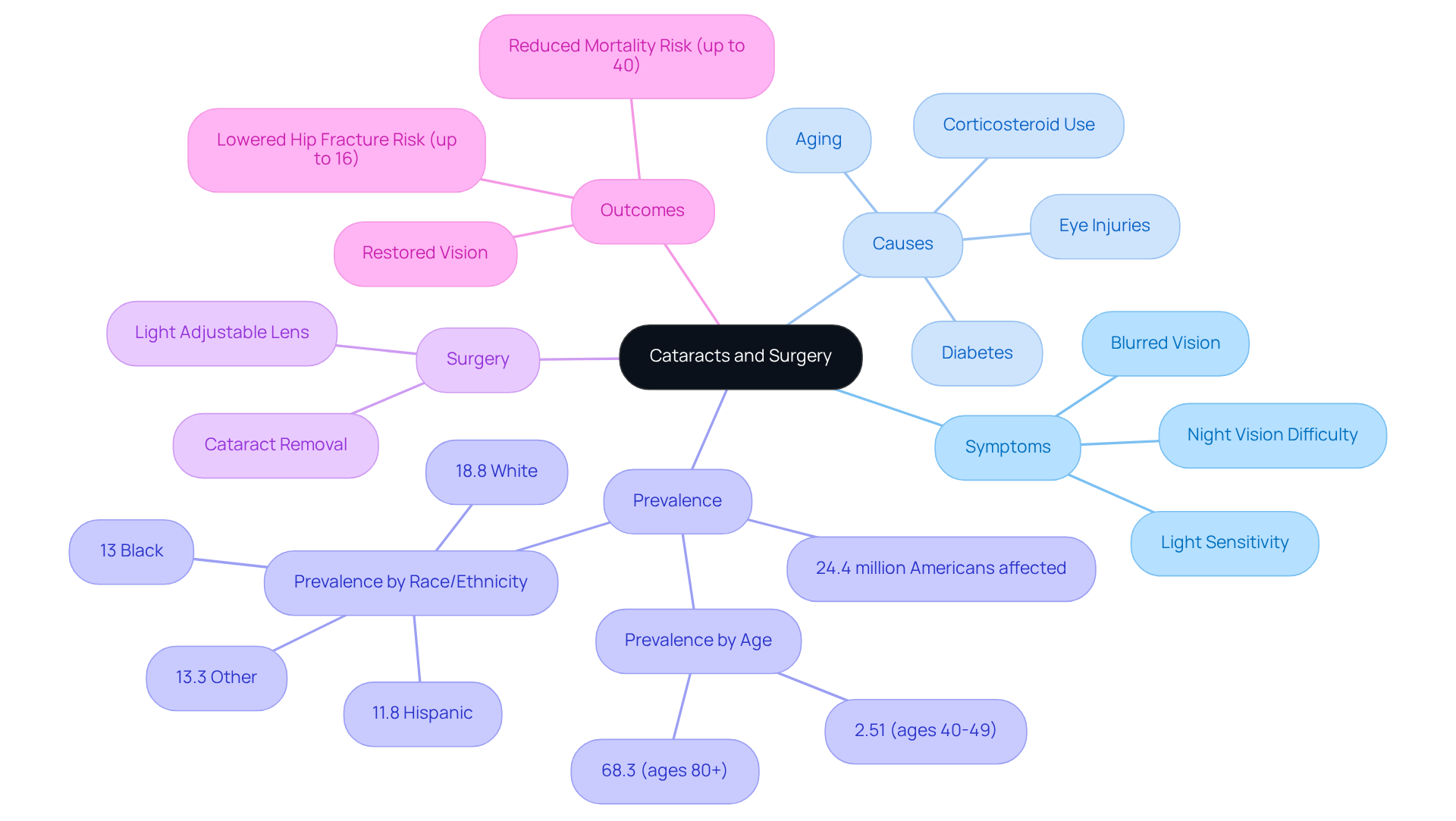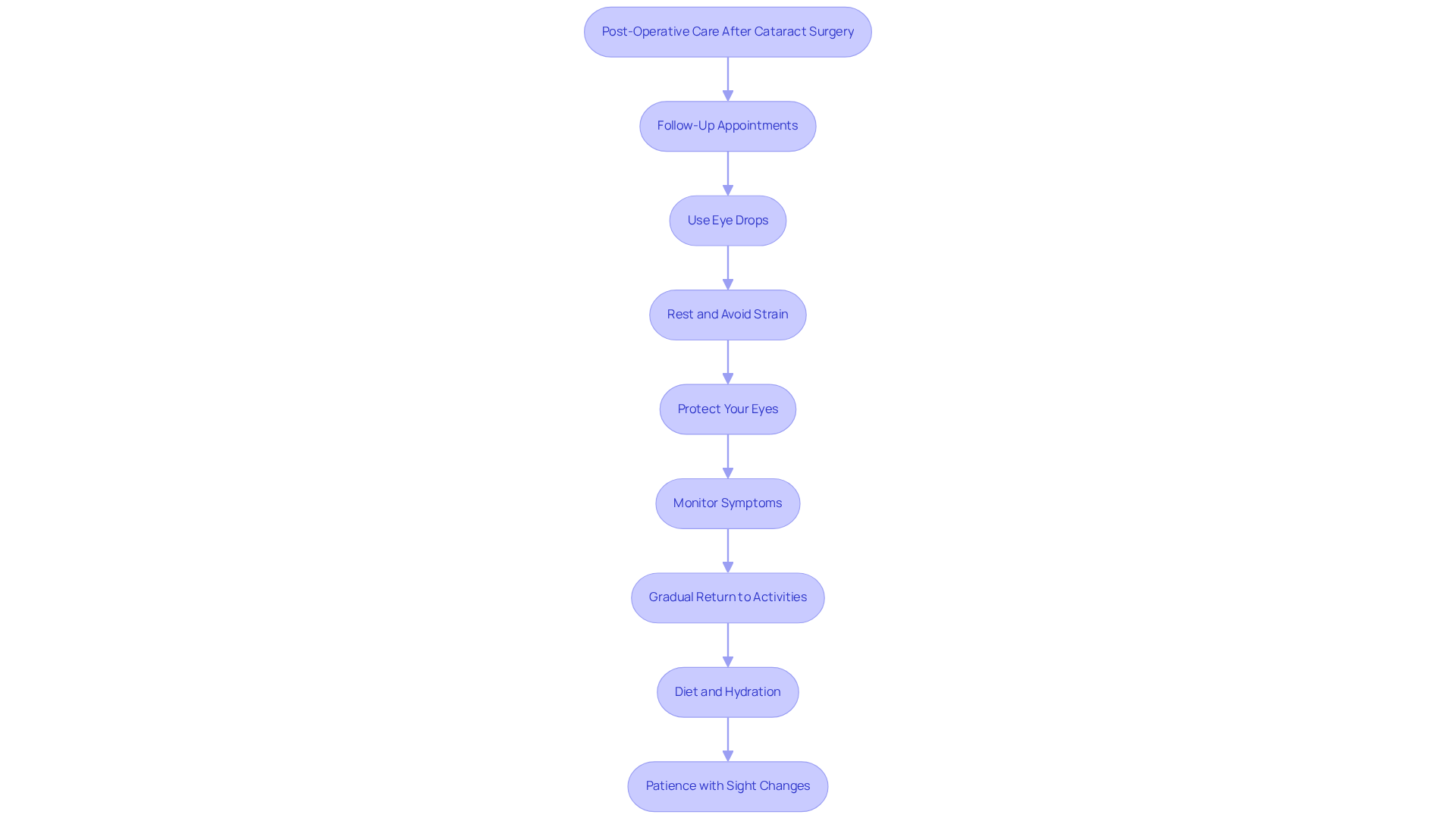Posted by: Northwest Eye in Cataracts, Vision Correction on November 8, 2025
Overview
Cataract removal surgery can feel overwhelming, and it’s completely normal to have questions and concerns. We understand that preparing for this procedure involves several essential steps, including consultations, health assessments, and post-operative care. These preparations are crucial for ensuring a successful outcome and a smooth recovery.
Proper planning and following medical advice can significantly enhance your healing process and improve your vision after the surgery. It’s important to take these steps seriously, as they lay the foundation for your recovery. Remember, you’re not alone in this journey; many patients have walked this path and found reassurance in the support they received.
Here are some key steps to keep in mind:
- Consultations: Discuss your concerns and expectations with your healthcare provider.
- Health Assessments: Undergo necessary evaluations to ensure you’re ready for surgery.
- Post-Operative Care: Follow your doctor’s instructions closely to promote healing.
We are here to help you through this process, and we encourage you to reach out with any questions. Your comfort and well-being are our top priorities, and we want you to feel confident as you move forward.
Introduction
Cataracts are a common yet often misunderstood eye condition that can significantly impair vision and quality of life. We understand that facing the challenges posed by this ailment can be daunting for many. However, the prospect of cataract removal surgery emerges as a beacon of hope for those affected.
This article delves into the essential steps for preparing for surgery and navigating the recovery process, offering invaluable insights for those considering this life-changing procedure. It’s common to feel anxious about what happens after the surgery, and we’re here to help you through this process. How can one ensure a smooth transition back to daily activities?
By addressing your concerns and providing the necessary information, we aim to reassure you that you are not alone on this journey.
Understand Cataracts and the Need for Surgery
Cataracts can feel daunting, as they signify a clouding of the eye’s lens. This condition often leads to symptoms like blurred vision, difficulty seeing at night, and increased sensitivity to light, including halos and glare around bright lights. It’s common to feel concerned when experiencing blurred vision, which can arise from various irregularities, including lens opacities. This may also indicate other eye conditions that need attention.
While aging is the primary cause of lens clouding, factors such as diabetes, prolonged corticosteroid use, and eye injuries can contribute to their progression. We understand that timely identification of these symptoms is crucial, as unmanaged lens opacities can significantly impact daily activities. In fact, cataracts affect around 24.4 million Americans aged 40 and older, with a prevalence of 17.1% across the population. This number increases with age, reaching 68.3% for those aged 80 and older.
Cataract removal is the only effective remedy, where the opaque lens is replaced with a transparent artificial lens. One innovative option is the Light Adjustable Lens, which allows for post-operative adjustments to enhance your vision. Most patients experience restored sight after this procedure. For example, Richard B. from St. John, IN, achieved better than 20/20 vision following his surgery, a remarkable outcome that many hope for.
Moreover, replacing the eye lens can significantly reduce the risk of death by up to 40% and lower the likelihood of hip fractures by as much as 16%. If you notice any of these symptoms, we encourage you to consult your eye care provider at Northwest Eye. They can assess whether surgery is necessary and discuss the latest treatment options available. Remember, we are here to help you through this process.

Prepare for Your Cataract Surgery: Essential Steps
Preparing for cataract removal can feel overwhelming, but we’re here to guide you through each step with care and compassion. Here are some essential steps to help you feel more at ease:
-
Consult Your Surgeon: It’s important to have an open conversation with your surgeon about any concerns or questions you might have regarding the procedure. Understanding what to expect from cataract removal can significantly ease your pre-surgery anxiety.
-
Health Assessment: Schedule a pre-operative consultation with your primary care doctor to ensure you’re fit for the procedure. This may involve necessary blood tests or evaluations to confirm your overall health.
-
Medication Management: Take the time to review your current medications with your surgeon. You might need to pause blood thinners or certain supplements at least a week before surgery to minimize any risks.
-
Eye Drops: Your surgeon will likely prescribe antibiotic eye drops to use before the procedure to help prevent infection. Start using these as directed to promote optimal eye health leading up to your surgery.
-
Fasting Instructions: Typically, you’ll need to fast for 12 hours before the operation, which means no food or drink after midnight the night before.
-
Transportation: It’s crucial to arrange for someone to drive you home after the surgery, as you won’t be able to drive yourself due to the effects of anesthesia.
-
Dress Comfortably: On the day of your operation, wear loose, comfortable clothing. Avoid makeup, lotions, or perfumes that could irritate your eyes during the procedure.
-
Post-Procedure Preparation: Prepare your home for recovery by creating a cozy resting space. Make sure essential supplies, like eye drops and pain relievers, are easily accessible for your use after the procedure.
What to Expect with the LAL Procedure: If you’re considering the Light Adjustable Lens (LAL) as part of your cataract removal, expect a thorough consultation to discuss your visual needs and determine if the LAL is the right choice for you. The LAL is implanted during a routine outpatient procedure that takes about 15-20 minutes per eye and is often performed in conjunction with cataract removal. After surgery, wearing UV-blocking glasses is essential to protect the lens during healing, and attending follow-up appointments for light adjustments over the next few weeks is important. Many patients report significant improvements in their daily activities without glasses, enjoying sharper, clearer vision tailored to their unique needs. Remember, most patients notice enhanced sight within one to three days after surgery, with 95% achieving complete restoration after receiving a standard intraocular lens (IOL).
We understand that this process can be daunting, but we’re here to support you every step of the way.

Manage Post-Operative Care and Recovery Expectations
After your cataract surgery, especially if you received the innovative Light Adjustable Lens (LAL), it’s essential to follow these guidelines for a smooth recovery:
-
Follow-Up Appointments: We understand how important it is to monitor your healing process. Please attend all scheduled follow-up visits with your surgeon. These appointments are crucial for addressing any concerns that may arise, particularly since the LAL allows for adjustments to your vision post-surgery.
-
Eye Drops: Using the prescribed eye drops as directed is vital. This helps prevent infection and reduces inflammation, ensuring a smoother recovery.
-
Rest and Avoid Strain: It’s common to feel the need to jump back into your routine, but make sure to rest your eyes. Avoid strenuous activities, heavy lifting, or bending over for at least a week after surgery. This will help reduce the risk of complications. Also, steer clear of swimming pools, saunas, and hot tubs for at least one week.
-
Protect Your Eyes: Wearing sunglasses outdoors can shield your eyes from bright light and dust. An eye shield may also be recommended while sleeping for the first few nights to protect your healing eye.
-
Monitor Symptoms: Stay alert for any unusual signs, like increased pain, redness, or changes in your vision. If you notice these issues, contact your surgeon immediately. Early detection can lead to better outcomes.
-
Gradual Return to Activities: Most patients can resume light activities within a few days. However, it’s wise to avoid driving until your surgeon gives you the green light, usually after your first follow-up appointment.
-
Diet and Hydration: Maintaining a nutritious diet and staying hydrated is crucial for your recovery. We recommend avoiding alcohol and smoking, as these can impede healing.
-
Patience with Sight Changes: While many patients notice improved sight within days, complete recovery can take several weeks. Be patient as your eyes adjust to the new lens. This adjustment period is a normal part of the healing process. The LAL’s unique ability to be adjusted after the procedure allows for further improvement of your sight, enriching your overall experience.
Ophthalmologists emphasize that following post-operative care can significantly affect recovery results. Many patients report enhanced vision shortly after the procedure. As one expert noted, ‘Your world often looks brighter after cataract removal,’ highlighting the transformative potential of this procedure.
We are here to help you through this process, ensuring you feel supported every step of the way.

Conclusion
Cataract removal is a vital procedure that can restore clarity to your vision and significantly enhance your quality of life. We understand that the thought of surgery can be daunting, but knowing the steps involved in preparation and recovery can help alleviate anxiety and ensure a smoother experience.
It’s essential to consult with your healthcare professionals and adhere to pre-operative instructions. Following a structured post-operative care plan is equally important. From managing medications and arranging transportation to monitoring your recovery and attending follow-up appointments, each step plays a crucial role in achieving the best possible results. Many patients report remarkable improvements in their vision shortly after surgery, so we encourage you to remain patient and proactive throughout this journey.
Ultimately, deciding to undergo cataract surgery is significant and can lead to transformative changes in your daily life. By taking the necessary preparatory steps and committing to a diligent recovery process, you can look forward to enjoying a brighter, clearer world. If you’re experiencing symptoms of cataracts, please don’t hesitate to seek guidance from your eye care provider. Timely intervention is key to maintaining your eye health and improving your overall well-being.
Frequently Asked Questions
What are cataracts?
Cataracts are a condition characterized by the clouding of the eye’s lens, leading to symptoms such as blurred vision, difficulty seeing at night, and increased sensitivity to light.
What symptoms indicate the presence of cataracts?
Symptoms of cataracts include blurred vision, difficulty seeing at night, and increased sensitivity to light, including halos and glare around bright lights.
What causes cataracts to develop?
The primary cause of cataracts is aging, but other factors such as diabetes, prolonged corticosteroid use, and eye injuries can also contribute to their progression.
How common are cataracts?
Cataracts affect approximately 24.4 million Americans aged 40 and older, with a prevalence of 17.1% across the population. This number increases with age, reaching 68.3% for individuals aged 80 and older.
What is the treatment for cataracts?
The only effective remedy for cataracts is cataract removal surgery, where the opaque lens is replaced with a transparent artificial lens.
What is the Light Adjustable Lens?
The Light Adjustable Lens is an innovative option for cataract surgery that allows for post-operative adjustments to enhance vision.
What are the potential outcomes of cataract surgery?
Most patients experience restored sight after cataract surgery. For instance, one patient achieved better than 20/20 vision following the procedure.
Are there any health benefits associated with cataract surgery?
Yes, replacing the eye lens can significantly reduce the risk of death by up to 40% and lower the likelihood of hip fractures by as much as 16%.
When should I consult an eye care provider about cataracts?
If you notice symptoms of cataracts, it is advisable to consult your eye care provider to assess whether surgery is necessary and to discuss the latest treatment options available.






